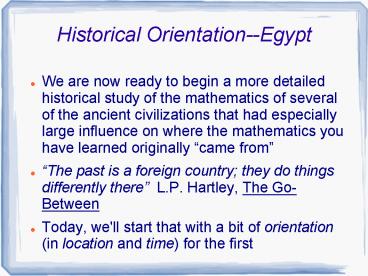Historical Orientation--Egypt - PowerPoint PPT Presentation
Title:
Historical Orientation--Egypt
Description:
Historical Orientation--Egypt We are now ready to begin a more detailed historical study of the mathematics of several of the ancient civilizations that had ... – PowerPoint PPT presentation
Number of Views:48
Avg rating:3.0/5.0
Title: Historical Orientation--Egypt
1
Historical Orientation--Egypt
- We are now ready to begin a more detailed
historical study of the mathematics of several of
the ancient civilizations that had especially
large influence on where the mathematics you have
learned originally came from - The past is a foreign country they do things
differently there L.P. Hartley, The Go-Between - Today, we'll start that with a bit of orientation
(in location and time) for the first
2
Geography of Egypt
- The gift of the Nile
3
Egyptian history
- 3200 - 2700 BCE -- predynastic period
- 3300 - 3100 BCE first hieroglyphic writing
4
Eventful history, stable culture
- 2650 - 2134 BCE -- Old Kingdom (pyramid-building
period) - 2134 - 2040 BCE -- First intermediate period
- 2040 - 1640 BCE -- Middle Kingdom (Moscow
mathematical papyrus) - 1640 - 1550 BCE -- Second intermediate period
(Hyksos) Rhind (Ahmes) mathematical papyrus
(possibly copying an older work from Middle
Kingdom)
5
Egyptian timeline, continued
- 1550 - 1070 BCE -- New Kingdom (some well-known
pharaohs include Thutmose III, whose name appears
the first example of hieroglyphics from above,
Amenhotep III, Akhenaten, Tutankhamen, Ramses II)
- after 1070 BCE -- Third intermediate period
- then Egypt ruled by Nubians, Assyrians, Persians,
Ptolemaic Greek dynasty (until Cleopatra),
Romans, Byzantines, Islamic caliphate, Ottomans,
British,
6
History lost and regained
- How do we know about a lot of this?
- Much of this history was lost when the
hieroglyphic system fell completely out of use in
the Roman period (it had become extremely archaic
and probably readable only by a few trained
priests long before that) - But, inscriptions could be read again after
Jean-Francois Champollion (1790 1832 CE) began
the decipherment, with the help of the
inscriptions on the Rosetta Stone
7
The Rosetta Stone
8
Egyptian hieroglyphics
- A very rich system with phonetic signs for single
sounds, combinations of sounds, plus a few
ideographs (signs representing ideas) - Pretty much the antithesis of the cuneiform
script from Mesopotamia that we'll study later in
terms of the variety of signs! - Some of the most recognizable symbols are the
names of kings and queens given in the oval signs
called cartouches (Champollion's detective
work used cartouche for Ptolemy!)
9
Tutankhamen's Cartouches
- Each king had a principal pair of names birth
name and throne name (as well as several
others)
(note how hieroglyphs also function as
decoration)
10
Other Egyptian writing
- Hieroglyphics were formal Egyptian written
language, used mostly for temple or tomb
inscriptions carved in stone, grave goods
(coffins, etc.) meant to last. - The Egyptians also used a paper-like writing
medium called papyrus manufactured from plant
material grown along the Nile for everyday
writing scrolls with stories, business records,
school exercises, - Hieratic and demotic (as in middle panel of
Rosetta Stone) writing forms as well
11
An Egyptian mathematical papyrus
- A portion of the Rhind papyrus
12
Egyptian number symbols
- The Egyptians, like us, used a base 10
representation for numbers, with hieroglyphic
symbols like this for powers of 10
13
Egyptian numbers
- The Egyptians did not really have the idea of
positional notation in this system, though. - To represent a number like 4037 (base 10) in
hieroglyphics, the Egyptians would just group the
corresponding number of symbols for each power of
10 together four lotus flowers, 3 hobbles, 7
strokes (something like a simpler version of
Roman Numerals). - There were separate and more involved number
systems used in hieratic writing.
14
Egyptian arithmetic
- Even though the Egyptians used a base 10
representation of numbers, interestingly enough,
they essentially used base 2 to multiply (!) - Called multiplication by successive doubling
- Example Say we want to multiply
- 47 x 26
15
The Egyptian way
- Successively double
- 1 x 26 262 x 26 524 x 26 1048 x 26
20816 x 26 41632 x 26 832 - (stop here since 32 x 2 64 gt the first factor,
which is 47)
16
The calculation concluded
- Then to get the product 47 x 26, we just need to
add together multiples to get 47 x 26 - 47 32 8 4 2 1, so
- 47 x 26 32 x 26 8 x 26 4 x 26 2 x 26
1 x 26 832 208
104 52 26 1222 - Note this essentially uses 47 (base 10)
101111 (base 2)!
17
Comments
- Important to realize that the calculations here
were just doubling and addition, not calculation
of all the intermediate products by
multiplication(!) - We used modern numerals here the Egyptians
would have used their own symbols, of course! - More efficient to reorder the factors as 26 x 47
would require fewer doublings - Egyptian scribes would have been very adept at
this and other tricks for using this system
18
Egyptian fractions
- Probably the most distinctive feature of the way
the Egyptians dealt with numerical calculations
was the way they handled fractions. - They had a strong preference for fractions with
unit numerator, and they tried to express every
fraction that way, for example to work with the
fraction 7/8, they would split it up as - 7/8 ½ ¼ 1/8.
- More on this next time!






























